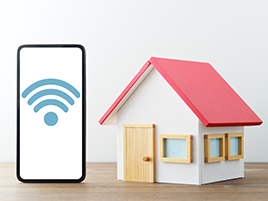Brought to you by Primus - a smart choice for your Internet and Home Phone services.

Are there parts of your house where you can’t get any Wi-Fi? Sounds like you have a dead zone. Here’s how to identify dead zones and what to do about them.
What Is a Dead Zone?
A dead zone is an area of your home where the Wi-Fi signal gets weak, cuts in and out, or just doesn’t reach. Cue frustration, am I right?
What Causes a Dead Zone?
There are a number of factors that cause dead zones. Anything that can block a radio signal can mess up your Wi-Fi signal. Maybe you have thick walls or really heavy furniture blocking the path. Or maybe you’re in a really old house that has a layer of chicken wire under plaster. That metal will for sure mess up Wi-Fi. A running microwave or other electrical equipment can screw with the signal. A simple explanation is often just multiple walls or floors. If your router is on the ground floor, and there are two floors and multiple walls between it and your office, you’ll have a hard time getting Wi-Fi up there. Or there’s the most simple explanation: your router only broadcasts so far, and your home is bigger than its effective range.
How Can I Measure Dead Zones?
The easiest way to measure dead zones is to pull out your phone and try to browse while slowly walking around your home. The better way is to pull up a speed test page and test areas of your home you suspect are dead zones. The very best way is to download a Wi-Fi analyzer app, such as Network Analyzer, Network Signal Info, or Scany, and walk around testing your Wi-Fi.
What Can I Do About Dead Zones?
Let’s assume that your router is placed in the best possible spot. That is, near the centre of your home and away from any walls. Let’s also assume you’re running a Wi-Fi 6 router. If you’ve taken those two steps and you still have Wi-Fi trouble, you should look into a mesh Wi-Fi setup.
With mesh Wi-Fi, you have more than a router broadcasting Wi-Fi. You also have a little network of nodes. Nodes are little devices that connect back to the router and to each other while also broadcasting Wi-Fi. This way, you get multiple devices sending Wi-Fi signals instead of only relying on a router. Say you have trouble getting Wi-Fi on the second floor. Well, you could put a node right at the top of your stairs so that there’s little blocking it from the router downstairs. From its upstairs position, this node broadcasts a stronger Wi-Fi signal to your second floor.
The nice thing about mesh Wi-Fi is that it’s completely scalable. You could have a little network of just a router and two nodes. Or you could have a massive one with six nodes that spread Wi-Fi to all areas of your house, garage, and yard. And unlike range extenders, mesh nodes don’t reduce bandwidth.
Are There Other Ways to Fix Dead Zones?
The non-technical solution to fixing dead zones involves moving furniture or moving walls. You’re better off with the technical solution.






